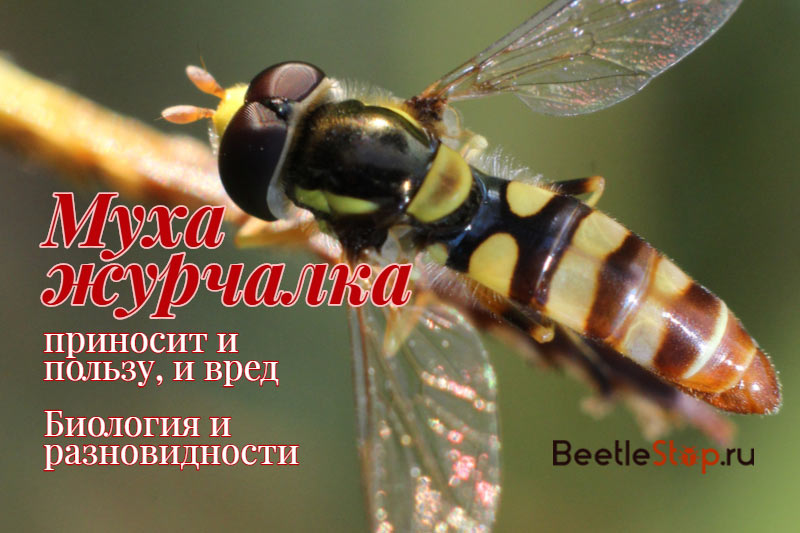Cricket fly - a vivid example of mimicry
Many gardeners saw these unusual insects that look like biting wasps or bees, but behave a little differently: their flight is not organized so, they collect the wrong pollen. This is a fly-like fly resembling them, a striking example of natural mimicry. This color protects the fly from birds of prey.
Reference! Mimicry is a natural property of plants and animals that allows them to survive in the external environment. It manifests itself in similarity with other species or with the general picture of nature.
In general, this insect looks very impressive, but thanks to modern technologies and the possibilities of such a direction of photography as macro photography, we can consider it in great detail. So, for example, the head of a fly flies in the photo below.

Insect biology
The family of insects of the female beetles belongs to the order of dipterans, in contrast to wasps and bees, which have two pairs of transparent wings. They are distributed throughout the globe and are found in almost all places except the desert and tundra, only in Russia they number more than eight hundred species.
The color of the insects of this family is black-yellow with slight changes observed in all species. Adults, adult female flies feed on pollen and nectar of plants, but larvae of female fly have a wider palette of tastes.
Development
Adult insects appear in the garden in late spring. Mating of flies of beetles takes place in the middle of summer, and their active years last until the beginning of August. Each female is capable of laying up to two hundred white eggs. She places them on grass, plant stems, directly in the soil, on tree branches. It depends on the type of insect. For example, an onion bug, which is a pest of this crop, lays eggs on onion feathers. Ten days later, larvae hatch from the eggs.
Larva
All fishermen and their wives are well aware of the larva of the meat fly - maggot. The larva of a flyfly is the same maggot, only a little smaller in size, just a centimeter long.
Larvae feed depending on their species:
- predators - aphids and leaf clouds;
- herbivores - with bulbs;
- water - detritus;
- woody - dead plant tissue, including manure.
Based on the foregoing, we see that basically these insects are useful, but there are pests in the garden.
Types of Creepers
The most common types of germs that can be found in our gardens and kitchen gardens are useful, and only onion is an undoubted pest. Below are examples of the most common flies of this family:
- Onion, in Latin "Delia antique", has a size of up to a centimeter in length. Larvae hatch from eggs laid in the sinuses of the eggs, which damage the bulbs, causing them to rot.
- Water gulls, or “Eristalis,” feed near stale water in small, natural puddles and swamps. The proboscis on the body, like a diver’s breathing tube, helps them breathe under the surface of the water.
- Common grub - a flower fly, reaching twelve millimeters in length. Its larva can eat up to two hundred aphids per day. The common beetle is an excellent pollinator. The camera captured her on clover
- The wasp fly is most similar to a wasp, hence its name.Its larvae feed mainly on rotten wood, and the adult grows up to eighteen millimeters in length.
- The bee-eater is a little smaller, only one and a half centimeters long, and has a darker color and, as the name implies, is similar to a bee.
Benefit and harm
As noted earlier, not all types of germs are equally useful. If most of them are excellent pollinators of flowering plants, and their caterpillars are able to destroy harmful insects, then the onion bug is a dangerous pest.
It damages the bulbs of such vegetable and flower plants as:
- onions;
- garlic
- tulips;
- gladioli;
- daffodils;
- hyacinths.
Plants damaged by the larvae of onion beetles slow growth, sometimes wither and die. Their bulbs also often rot and do not give themselves good reproduction.
Attention! Do not confuse an onion ginger with an onion fly. The fly is gray and slightly smaller than the bug, the maximum body length barely reaches eight millimeters. She activates earlier than the beetles for a whole month.
Fight
Having noticed the larvae of the larvae on the plantings of bulbous plants, immediate measures must be taken. In doing so, they proceed as follows, using both means for destruction and preventive measures:
- Heavily damaged plants are removed from the site and burned.
- The rest of the plantation is treated with conventional insecticides: Aktara, Decis, and so on.
- Every year they change the places of planting daylilies, alternating them with other cultures.
- Carrots are planted in lily plants, the smell of which repels onion flies and germs.
- Saves bulb crops and early planting, with the expectation that by the time of departure of pests they are already sufficiently strengthened.
- Preventive treatment with odorous substances is used: tobacco dust, naphthalene, ash, hot pepper and the like.
- Mulching and loosening the soil prevents its compaction, which is a barrier to pests.
After harvesting onion crops, if there was a suspicion of infection with beetles, it is advisable to treat the soil with a solution of copper sulfate.
At the end of the article, we recommend that our readers watch an interesting video about the fly-fly.


 (votes: 15, average rating: 4,73 out of 5)
(votes: 15, average rating: 4,73 out of 5)
the article is excellent, but in the last paragraph it is written about copper sulfate, why is it?
Copper from sores, and this is a pest ...